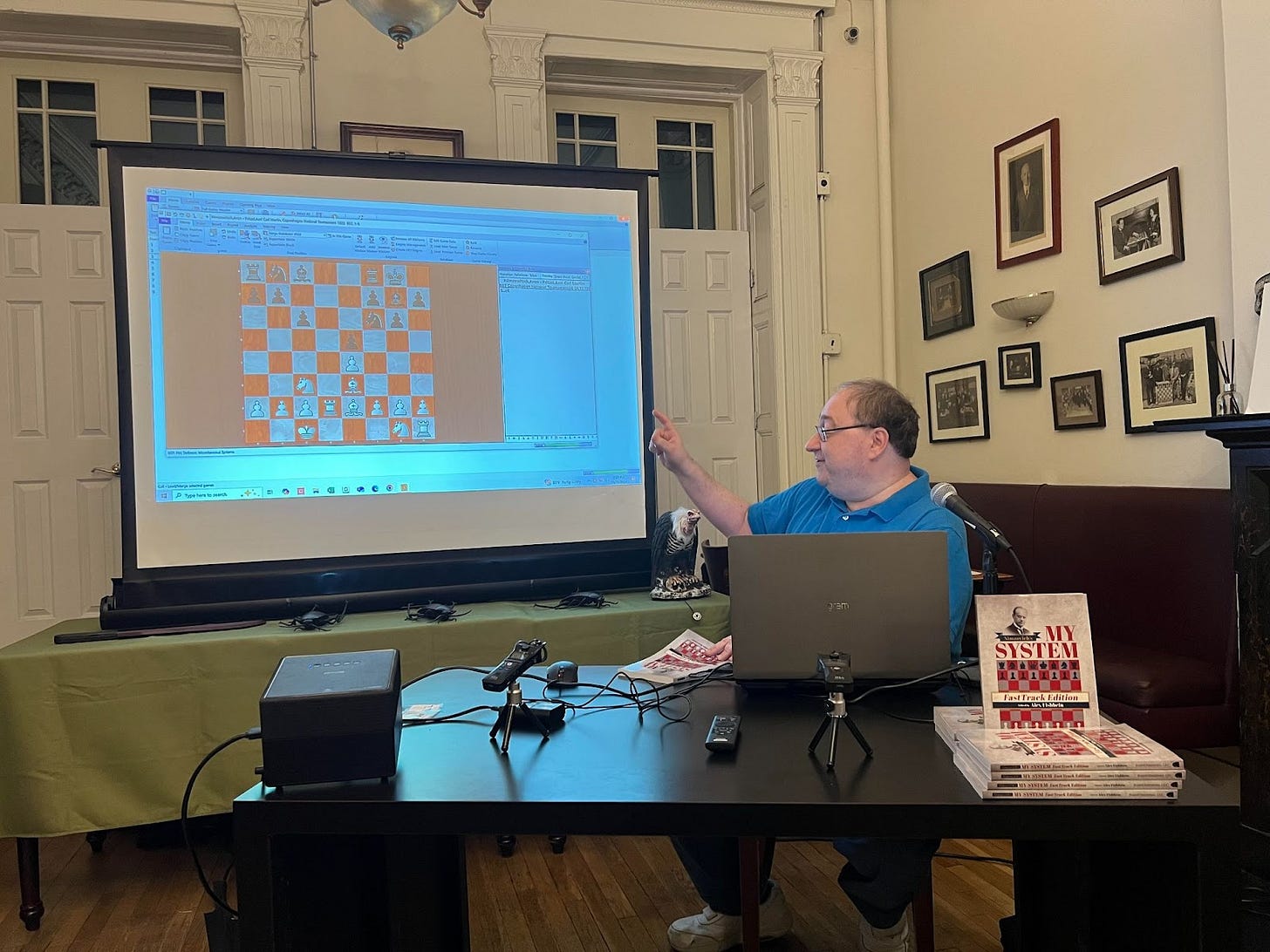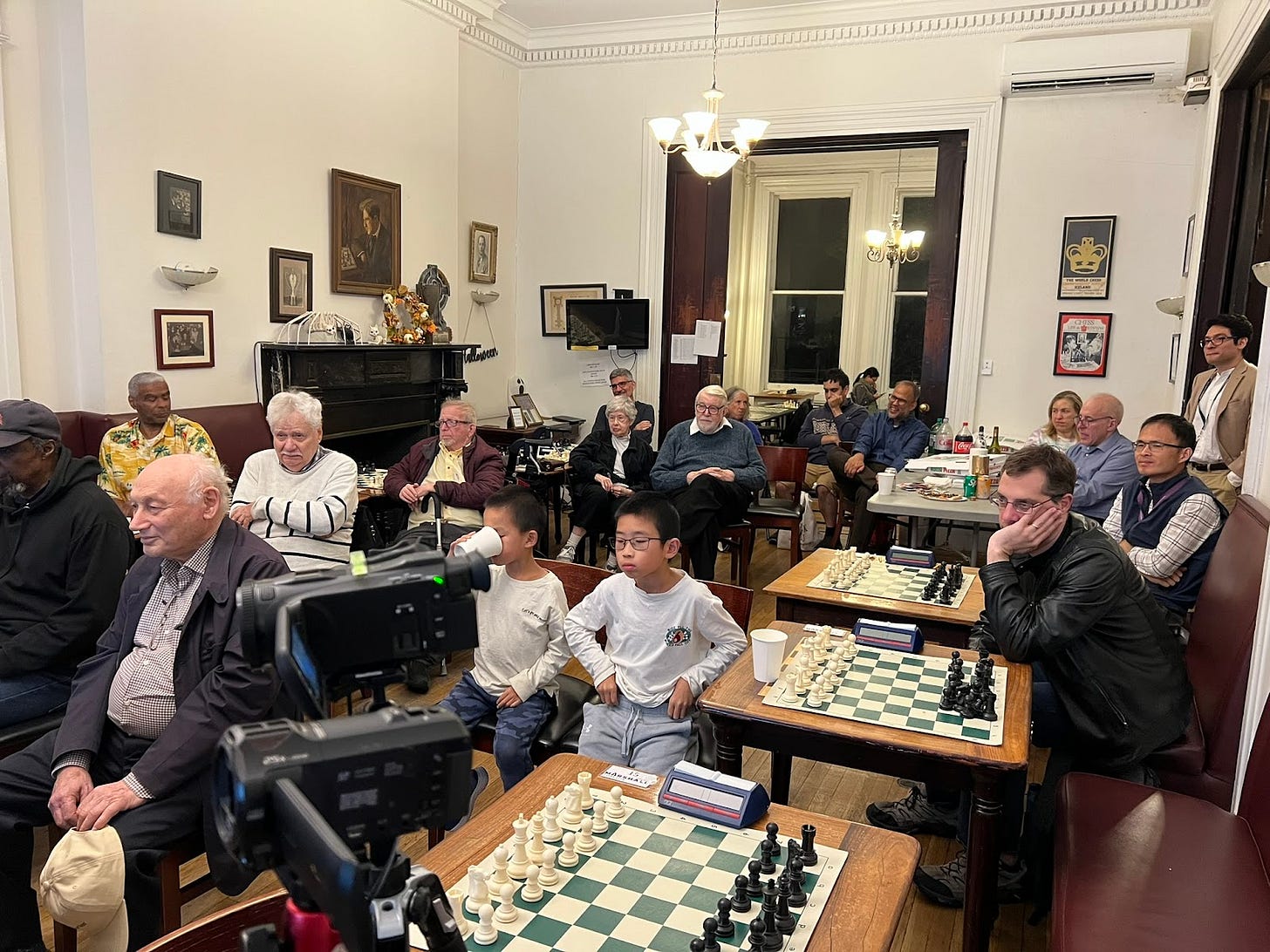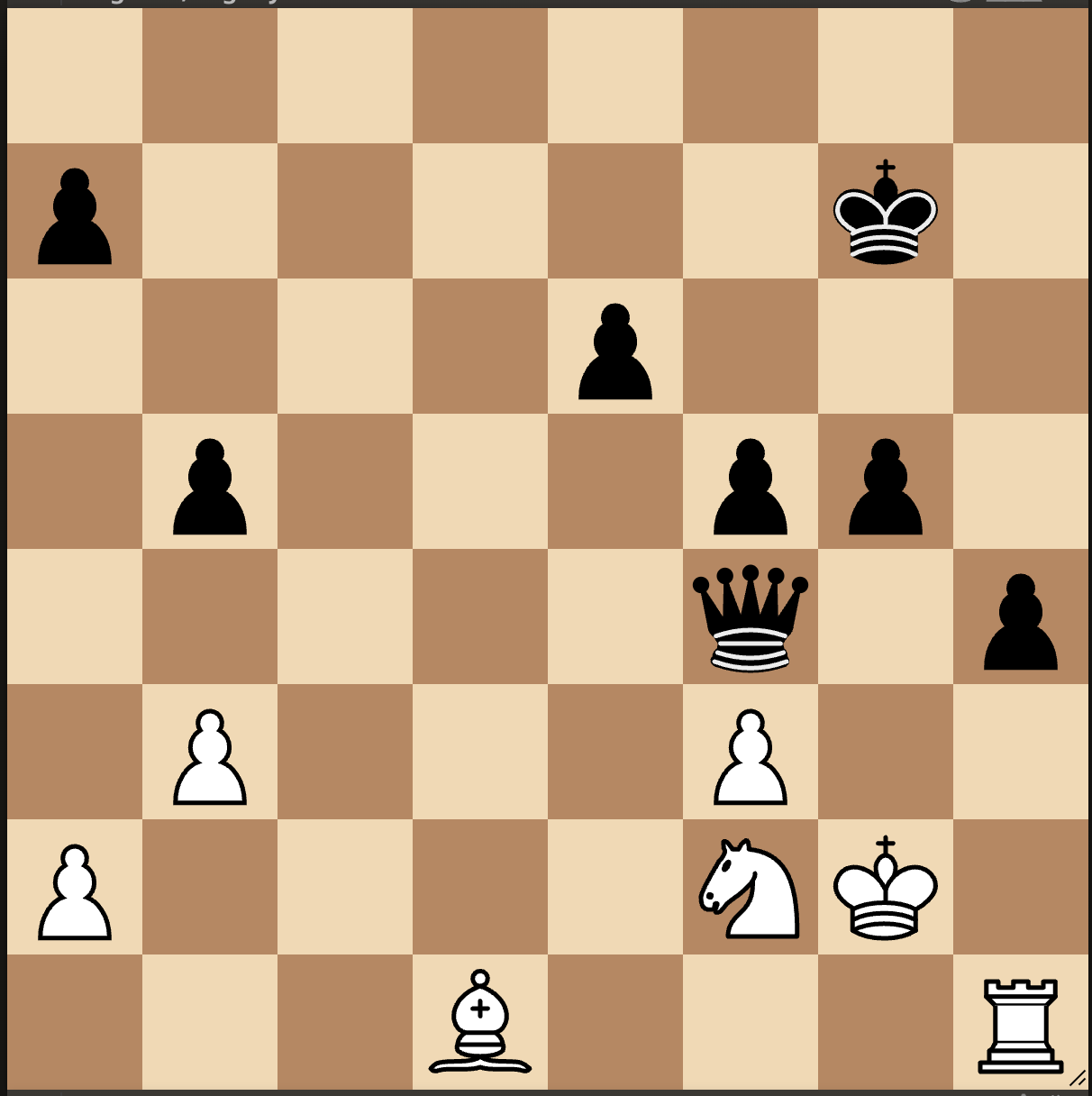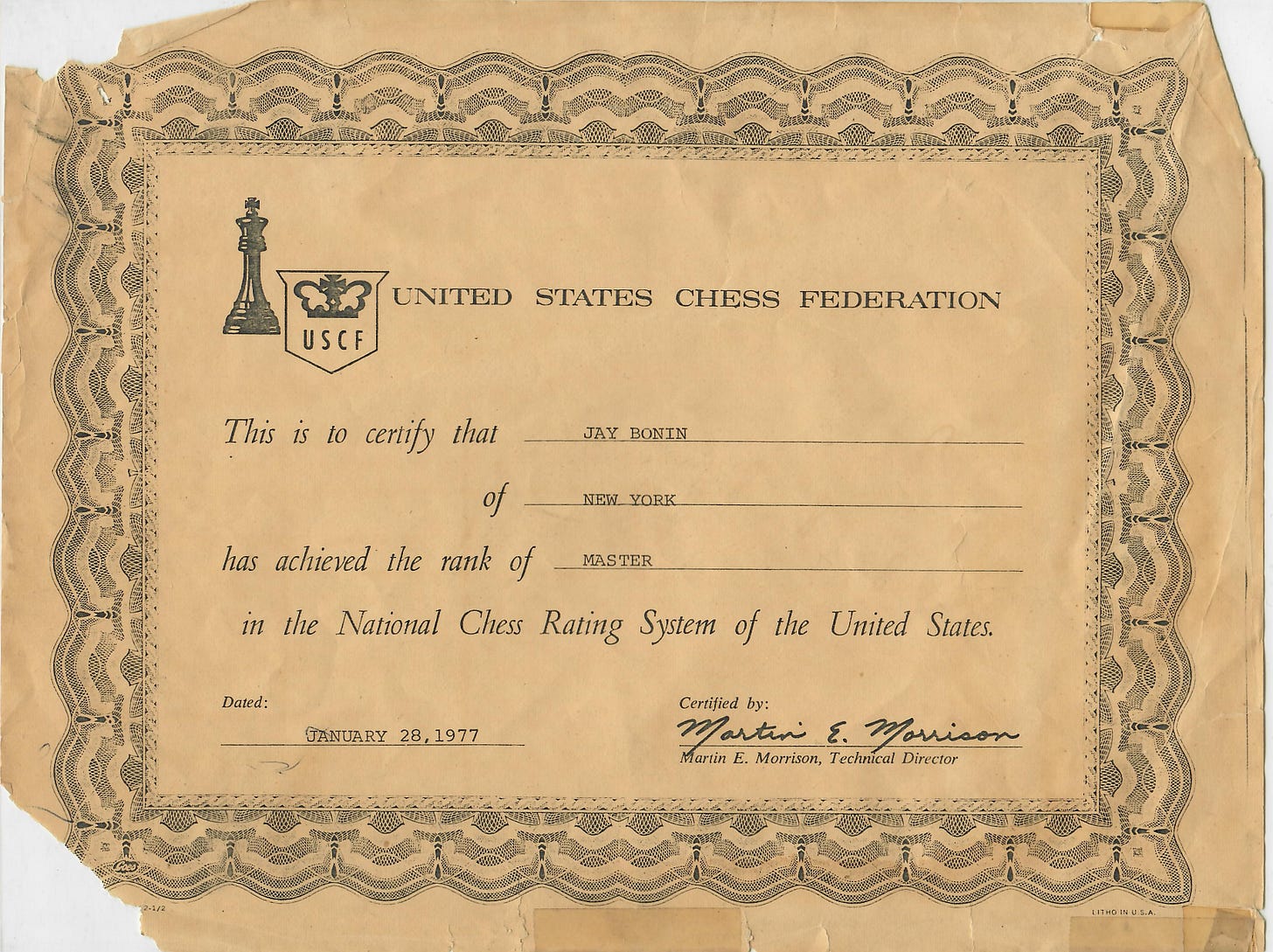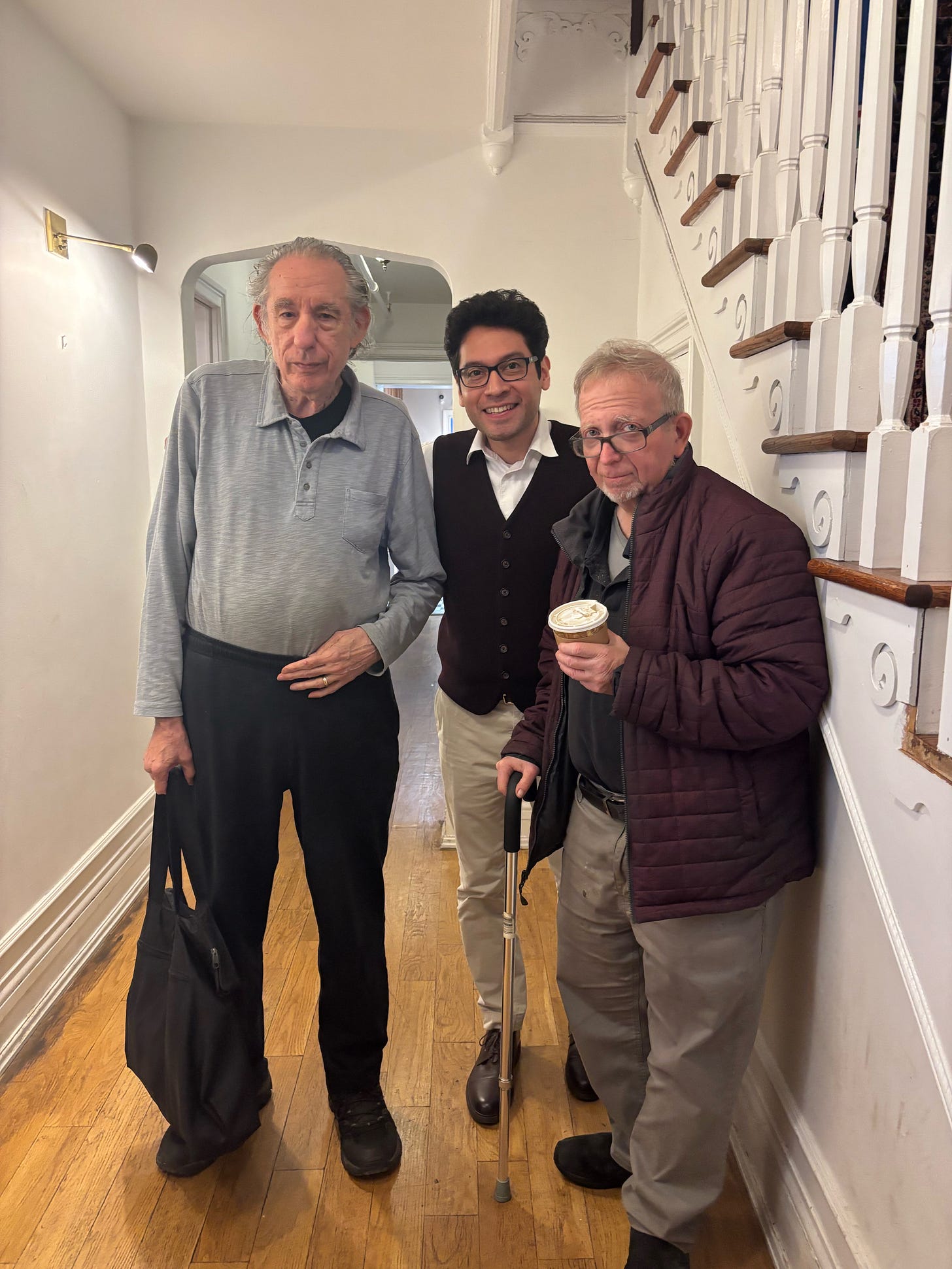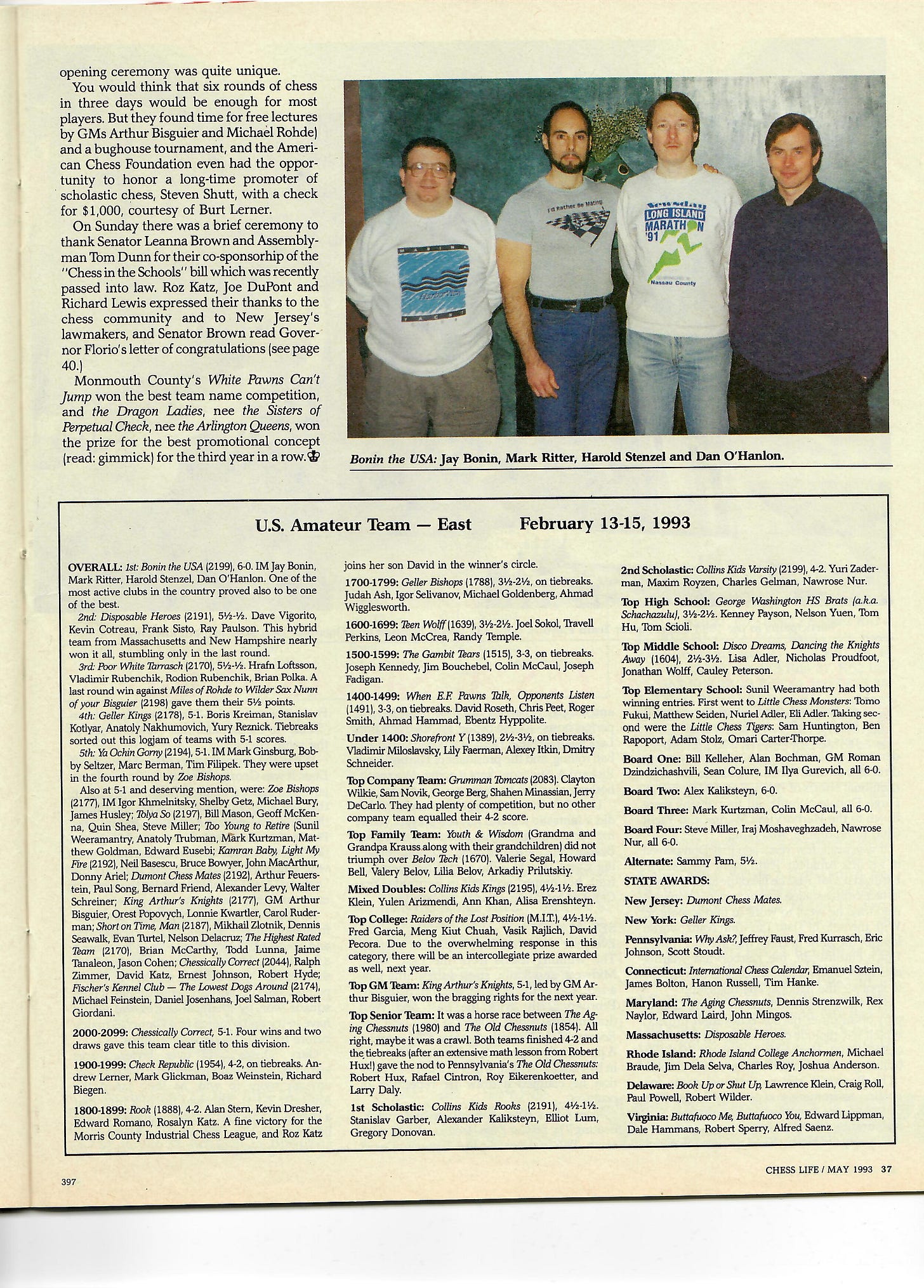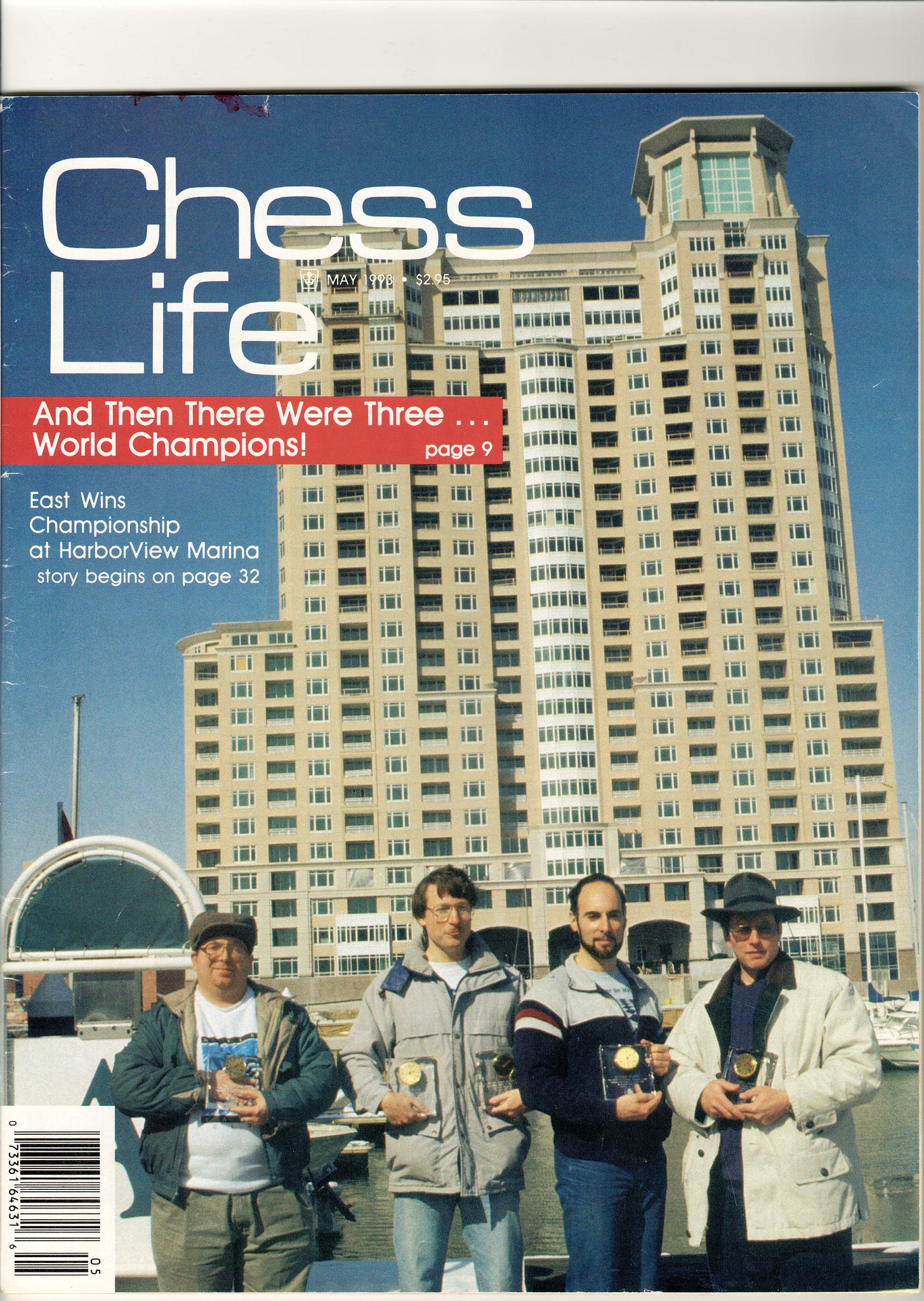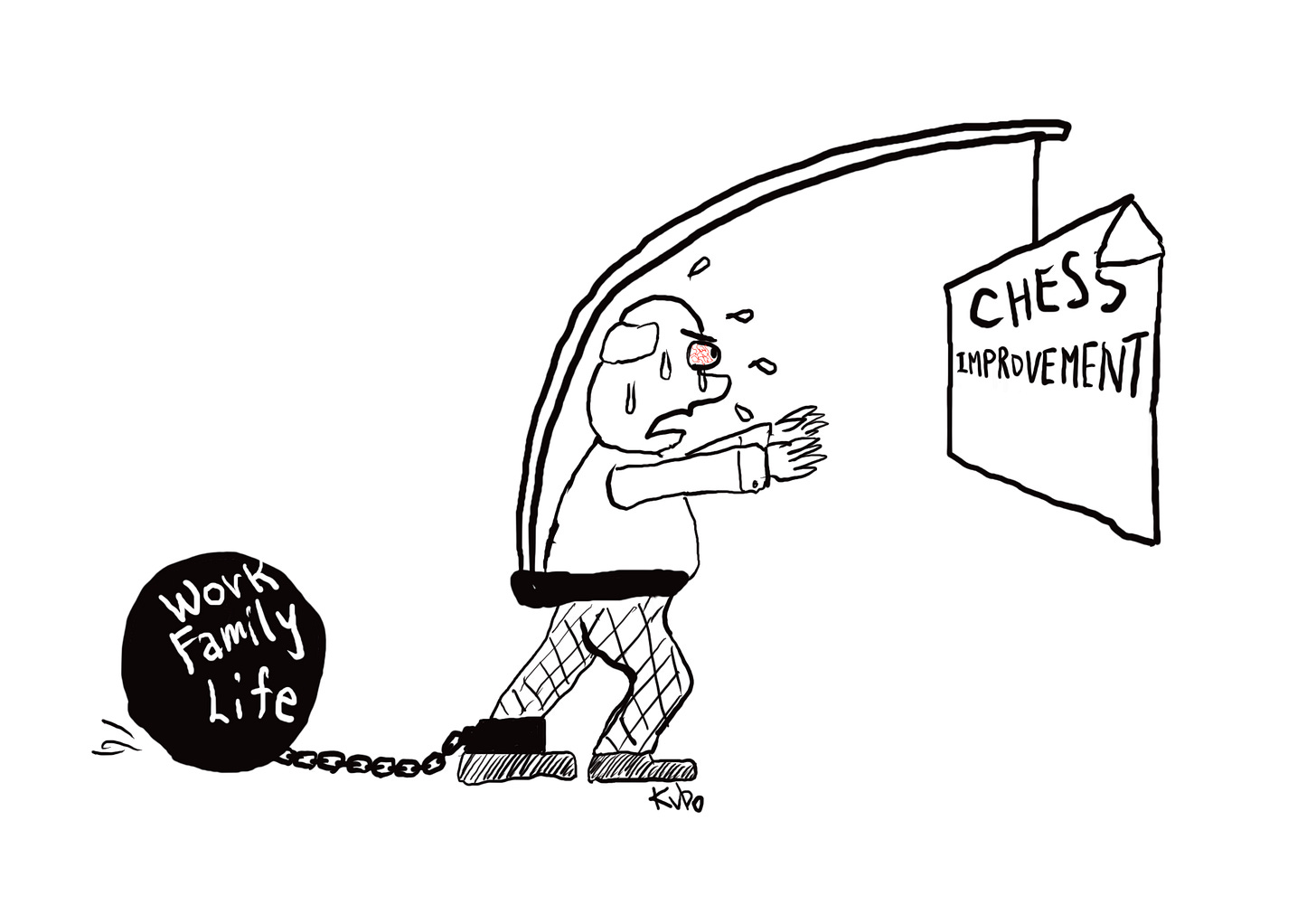In This Issue: From The Skittles Room Endgame Corner, by IM Silas Esben Lund Across the Table, with Jay Bonin Chess Toons En Passant Problems, Problems, curated by Alexander George Editor's Note
Welcome back, fellow chess players, to this edition of the Marshall Chess Club's fortnightly bulletin, The Marshall Spectator.
Grandmaster Alex Fishbein visited the Marshall Chess Club on October 29 to give a one-hour lecture followed by a book signing. He talked about his recent publication, the FastTrack edition of Aaron Nimzovich’s My System. If you were unable to attend the lecture, you can see it in its entirety here.
Before diving into some of his favorite positions in the book, Fishbein explained its appeal: “His genius was to explain some basic ideas in a way that (1) the language, the literary form, is so memorable that you will remember what he talks about for the rest of your life, and (2) the examples were chosen in a way that was very ubiquitous.”
He explained that the classic book’s reputation was somewhat tarnished in the computer era, as people found mistakes in the nearly century-old book. This FastTrack edition is a computer-checked version that’s also been streamlined for a quicker, more straightforward read. The lecture was followed by a book signing and a casual blitz tournament. You can watch the full video of the lecture here, or buy his book here.
Looking ahead to this weekend, November 15-17, the Mona Karff Memorial/Marshall Women’s Championship will run concurrently with the Marshall Chess Club Senior Championship. The following weekend, November 22 - 24, will be the Jerry Simon Memorial and Marshall Amateur Championship, which is also a qualifier for our club championship happening in December. The 108th annual Edward Lasker Memorial and Marshall Chess Club Championship will take place December 12-15, culminating with the crowning of the 2024 club champion.
We are proud to announce that we now text pairings to players! To get your pairings texted to you before the round, please sign up here:
If you are a parent and spend a lot of time in a nearby coffee shop waiting for your child to finish their round and would like to be notified when they enter a result on our pairings screens, sign up here and you will be texted the moment they enter a result!
Over the last two weeks we have had a plethora of events for our members to play in.
The Under 2000 Morning Action on November 9 had 46 players registered and was won by Aziz Abdijalilov, Tolani Somefun, and Armaan C Jain who scored 3 out of 3 to win $192 each.
The Saturday Game 50 Under 1800 on November 9 had 47 players registered and was won by Ateeq Panjwani, who scored a perfect 4 out of 4 to win the $276 first place prize. Kirill Tsydypov, Atticus Chew, and Caleb Garcia scored 3 out of 4 to share in a class prize, winning $46 each, while the following 8 players won $23 each for the same score: Cameron Edward Hull, Axel Peters, Liam L Kojuharov, David Gelpi, John Moina, Miles Wang, Sourya Gurram, and Shu Chen.
The Saturday Game 50 Open on November 9 had 27 players registered and was won by Derek Zhang, who scored a perfect 4 out of 4 to win the $162 first place prize. Sarathi Ray scored 3.5 to win the second place prize of $108, while Naveen Paruchuri and Shiv Dubey scored 3 points to win $40.50 each.
The Morning Masters on November 9 had 6 players registered and was won by Qindong Yang, who scored a perfect 3 out of 3 to win the $45 first place prize, while Daniel Wang scored 2 out of 3 to win the $30 second place prize.
The Women & Girls Open on November 8 had was won by Arvie Lozano, who scored a perfect 3 out of 3 to win the $84 first place prize, and the following 6 players won $7.00 each for ther 2 out of 3 score: Jessica Hyatt, Ashley Huang, Emmi Gaskins, Stephanie Ballom, Jessica Li, and Angelina Cheng.
The FIDE Blitz on November 8 had 45 players registered and was won by GM Maxim Dlugy, who scored 8.5 out of 9 to win the $225 first place prize. Linxi Zhu won the second place prize of $112.50 for his 7 out of 9 score, while GM Michael Rohde, Toshinori Underwood, and Michael Glick won $56.25 each for their 6.5 out of 9 performance, and Joseph Otero won $56.25 for his 6 point performance.
The Thursday Open that concluded on November 7 had 11 players registered and was won by FM Konstantin Dolgitser, who scored 5 out of 6 to win $150. Daniel Yassky scored 4.5 out of 6 to win $100, while George Berg scored 4 out of 6 to win $50. The following 3 players won $25 each for their 3 out of 6 score: Mossab Alsadig, John Brendel, and Alan McMichael.
The Afternoon Game 50 on November 7 had 8 players registered and was won by Arvie Lozano and IM Justin Sarkar, who won $15 each for their perfect 2 out of 2 score.
The Thursday Action on November 7 had 37 players registered and was won by Bryan Weisz, and Michael Glick, who scored a perfect 4 out of 4 to win $112.50 each. Arlo Joshua Scherr and Cameron Edward Hull won $34 each for their 2.5 out of 4 score, while the following 6 players won $22.67 each for their 3 out of 4 score: Philip Uy, IM Kevin Wang, Murodjon Shadiev, Joseph Otero, Oliver Chernin, and Wyatt Wong.
The Rated Beginner Open on November 3 had 40 players registered and was won by Theodore Stoffa Kowalski, Ashley Huang, and Sean Keenan, who scored a perfect 3 out of 3 to win $166.67 each.
The Marshall Premier FIDE Open that concluded on November 3 had 32 players registered and was won by IM Liam Putnam, who scored 4.5 out of 5 to win the $774 first place prize. IM Eshaan Hebbar and Haari Muthukumar scored 4 points to win $217.50 each, while the following 7 players scored 3 points, winning $34.57 each: Levon Tadevosyan, Chase Knowles, Luc Hoffman, Kireet Panuganti, Santhosh Ayyappan, Tim Shvarts, and Derek Li Chen.
The Marshall Premier Under 2000 that concluded on November 3 had 49 players registered and was won by David Campbell who scored a perfect 5 out of 5 to win the $817 first place prize. Leo Paas finished in second place, scoring 4 points to win the $327 second place prize. Aileen Lou won a class prize of $245 for her 3.5 out of 5 score. Dan Yates, Ryan Wang, and Rachitha Sai Chandar scored 2 points, winning $68 each as a class prize for their performance, while the following 7 players won $35 each, sharing in the a class prize for the same score: Ayden Lim, Fabrizzio Quinonez, Darwin Wong Okyere, Alexander William F Don, Tolga Ergin, Sai Avantika Chandar, and Hannah Chan.
The Under 2000 Morning Action on November 2 had 49 players registered and was won by Aaron Asbury and Arman Chandragupta Jain, who scored a perfect 3 out of 3 to win $215 each. Blake Herman, Aziz Abdijalilov, and Amiel Urilov scored 2.5 out of 3 to win $61.33 each.
The Friday Afternoon Action on November 1 had 8 players registered and was won by Matt Biancuzzo who scored a perfect 3 out of 3 to win the $60 first place prize. Cameron Hull, Anthony Wang and Ateeq Panjwani scored 2 points out of 3 to win $13.33 each.
The Wesley Hellner Action on October 31 had 16 players registered and was won by Philip Uy, who scored a perfect 4 out of 4 to win the $75 first place prize. Samer Sabri scored 3 out of 4 to win the second place prize of $50, while Andrew Colwell, David Campbell and Akash Shah scored 2.5 to win $38 each.
The Monthly Under 1800 that ended on October 28 had 28 players registered and was won by Andrey Zubov and Jack Murtagh, who scored 4.5 out of 6 to win $163.50 each. Sydney Strauss and Thyge Knuhtsen scored 3 points to win $70.50 each, while the following 4 players scored 4 points winning $23.50 each: Richard Koppenaal, Matthew Biancuzzo, matt McColgan, and Ryan Dugre.
The FIDE Monday that ended on October 28 had 38 players registered and was won by FM Grant Xu, NM Anthony Levin and WFM Abby Marshall, who scored 4.5 out of 6 to win $247 each. Nicklas S Breskin scored 3.5 out of 6 to win a class prize of $124, while Alex Pakh and Jude Kazan scored 3 out of 6 to win $31 each.
We look forward to seeing you at the club soon!
Endgame Corner, by IM Silas Esben Lund
The following position is about queen versus 2 rooks. When is the queen stronger than the rooks, and when can the rooks claim the advantage of 2 versus 1? Try to answer the question first; the solution will follow later.
Should Black play 26... Bxd4 to enter a position with queen and pawn versus 2 rooks? After 27. Nxd4 Rxd4 28. Qxd4 Rxd4 29. Rxd4… how do you evaluate the position?
Hjartarson, Johann vs. Pigusov, Evgeny
You can play through the game with annotations here.
The solution to the exercise:
26... Bxd4 27. Nxd4 Rxd4 28. Qxd4 Rxd4 29. Rxd4 Nf5 30. Rd8+ Kg7 To be fair, this is not only a position with queen versus 2 rooks, each side has an additional 2 minor pieces as well. And this is the main problem for White: Black's bishop and knight are far more active and useful than White's. The black bishop on c6 is anchored to b7, controls the entry square d7 and controls the white knight on c3. Meanwhile, White's bishop is hitting a wall of pawns on f7-e6. Black's knight is also active on f5, aiming for h4 to attack the vulnerable pawn on g2. As it turns out, Black will have an attack with his 3 remaining pieces QBN, forcing White on the defensive. In terms of the white rooks, they are not able to coordinate an attack against the possible targets in the black position (f7, h6).
31. Ne2 White is preparing to defend. 31…Nh4 32. R8d6
32…Nxg2 I like this transformation that gives a material configuration of Q versus RBN. From the current situation, Black sacrifices 2 minor pieces for rook and 2 pawns. Humans like these kinds of material transformations when converting an advantage, whereas the engines are usually not impressed. (A more straightforward way was 32... Qc5 33. Nd4 Bxg2)
33. Rxc6 Qxc6 34. Nd4 Qe4 35. f3 White's point: the black queen can no longer defend the knight.
35…Qh4 36. Kxg2 Qxh5 White's minor pieces are still not active, and he won't be able to coordinate his 3 pieces effectively. Black has queen and 3 pawns, with multiple weaknesses (b2, f3) and an open king. Meanwhile, Black's king is safe on the dark squares, and he can slowly start pushing the kingside pawns.
37. Rh1 Qg6 38. Ne2 h5 39. Ng3 h4 40. Ne4 Qf5 41. Bd1 Qf4 42. b3 f5 43. Nf2 b5
Good technique: while White is tied up on the kingside (stopping g5-g4), Black starts to play on the other side, trying to create more weaknesses.
44. a4 b4 Grabbing space and fixing b3 as a target.
45. Be2 Qe5 46. Bc4 Qg3+ 47. Kf1 Qxf3 48. Rh3 (48. Bxe6 g4) 48... Qf4 49. Bxe6 g4 The point is the double attack with Qf6.
50. Rxh4 Qc1+ 51. Ke2 (51. Kg2 Qc6+) 51... Qc2+ 52. Kf1 Qc1+ (Or 52... g3 53. Nh3 Qd3+ 54. Kg2 Qe2+ 55. Kxg3 Qxe6 (Ambroz).)
53. Ke2 Qb2+ 54. Kf1 Qf6 55. Bxf5 White is trying to build a fortress.
55…Qxh4 56. Bxg4 Kf6 57. Be2 Ke5 58. Bc4 Kd4 59. Nd1 Qh2 Black breaks the 'fortress' by playing for checkmate with king and queen. Again, White is weak on the dark squares.
60. Ke1 a5 61. Nf2 Qg3 62. Ke2 Qe3+ 63. Kf1 Qd2 64. Kg1 Qc2 65. Kf1 Ke3 66. Ng4+ Kf3 67. Ne5+ Kf4 White resigned. 68. Nd3+ Ke3 69. Kg1 Qe2 Black goes for checkmate. (Black can also simplify to win: 69... Qxd3 70. Bxd3 Kxd3) 70. Kh1 Kf3 71. Bd5+ Kg3 0-1
IM Silas Esben Lund, Marshall Spectator Contributor
Across the Table, with IM Jay Bonin
1. IM Jay Bonin, tell us about how you got into chess and what was it about the game that intrigued you?
I got into the game in 1970. I watched 2 classmates play on a little wooden set in the homeroom. It caught my eye. I went out to a toy store and bought a set. The rest is history.
2. You are self taught, can you tell us what you did to become a very good chess player? What chess books did you study, what players did you associate with and learn from?
I was working as a camp counselor in the summer of 1972. I was on a break and a TV was on and it was Shelby Lyman analyzing the Fischer vs Spassky Championship match. That got me hooked. I started to look for places to play and I bought a couple of books. My first book was a gift from a neighbor. Mr Jack! It was the Soviet School of Chess by Kotov and Yudovich. Other early books included mco and Horowitz openings. Nimzowitsch’s Praxis of my System. Logical Chess Move by Move. Reuben Fine’s Endgames book etc. I took a couple of lessons with George Kane and Frank Thornally. I never really had further formal instruction but I got a lot of pointers from FM Asa Hoffmann.
3. When did you start coming to the Marshall Chess Club? What was your first impression? What other chess clubs did you compete in?
I joined the Marshall Chess Club in Nov 1972. This is after various visits to the Chess and Checker Club of NY and Charles Hidalgo’s Chess House during the summer and early fall. I was greeted by the day manager Bill Slater. He made me feel very welcome. I loved the cavalier style pieces and wooden analogue clocks and every table had its own lamp. I joined other clubs along the way. The Manhattan Chess Club in 1984. Nassau in 1981. And the Queens Club in 1996. I visited other clubs like the Fairfield in Connecticut and Chessmates in Rahway, NJ. But I consider the Marshall my home away from home. I also played in Bill Goichberg’s Chess Center of NY from 1980-1984. Tournaments every day. Where my legacy began.
4. You have the distinction of being the first player to have won the New York State Championship, Marshall Chess Club, and Manhattan Chess Club Championships in the same year. Where does this achievement rank in your successful chess career?
1997 will be a year to remember. I must add that I also won the Queens and Nassau championship as well. 4 club championships in one year. This will not be duplicated as the Manhattan club is out of business. Beating Sammy Reshevsky on my 27th birthday stands out. My first Grandmaster scalp. My 1986 NY open where I beat 3 GMs stands out. Beating Larry Christiansen in 1976 Pan-Am intercollegiate to earn my first master rating stands out. Other milestones include my first (A) player scalp Mathew looks in 1973. First expert Howard Ant in 1975. First master Bill Hook 1975. First senior master Christiansen.
5. How did you achieve your International Master title and what did it feel like to reach this milestone as a chess player?
I earned my IM title in Nov 1985. I made three norms to do it. The Frank Marshall International at the chesscenter in April 1983. The Barclay Gallery International in 1984. And the NY Open in March 1985. I did not need a minimum rating at the time. I did not have to pay a fee. Things are different now.
It was very satisfying to achieve this milestone as I struggled academically. Had trouble learning to read in first grade and took speech therapy in second grade
6. You are one of the most active players in the United States, what keeps you motivated to compete in tournaments and maintain a consistent level of play?
One reason I play is to see what I can do. Every tournament is a new challenge to overcome. Maybe I'll do something that's never been done before like castle queenside with a triple attack. To see if I can play while compromised. I played sick. I played drunk. I played while in pain. And won. Don't try this. I'm compromised right now but I can walk, eat, drink and play chess. Not dead.
IM Jay Bonin, Marshall Chess Club Member and 3-time Former Club Champion
Chess Toons
En Passant
Two and a half decades after GM Maurice Ashley became the first African American grandmaster, GM-elect Brewington Hardaway has climbed to the top of the mountain. Born in the Bronx, New York, 15-year-old Hardaway has completed the requirements to become the second African American grandmaster in history.
The third-round encounter between GMs Arjun Erigaisi and GM Alexey Sarana at the Chennai Grand Masters 2024 had two distinct phases: the first 23 moves, flawlessly played by both sides, and the rest marred by tactical errors. But what mattered was Arjun's resourcefulness which finally enabled him to win the game and reach the second position in live world ratings, overtaking GM Fabiano Caruana.
Just 18, Gukesh Dommaraju is on the cusp of an extraordinary achievement – he is about to fight against Ding Liren in the match that will determine the new world champion. " The year so far has been quite good," Gukesh said, reflecting on his recent successes. "A lot of interesting chess and some nice achievements. I'm really looking forward to the World Championship match in Singapore. It's coming soon, and I'm quite eager to start the match."
Problems, Problems, curated by Alexander George
W. von Holzhausen and M. Sohege, 1903
White to move and win.
This problem was a recent "Daily Puzzle" on chess.com. I found it very neat: it had a clear idea that has been marvelously captured in an economical setting. In fact, it was so nice, I wondered whether it might be a composed problem. There is of course much beauty that surfaces in over-the-board play - but usually that beauty is surrounded by the irrelevant rubble of a game in play. A successful chess problem takes the rough stone, facets it to increase its depth and sparkle, and embeds it in an attractive setting. So I searched around and, sure enough, found that this is a composed problem that was published over 120 years ago. I was glad chess.com offered it to thousands for enjoyment. But I wasn't glad that the site gave no inkling that some humans no doubt labored mightily to create this gem: no mention of its composers, not even that it is a composition. So, thank you Walther and Max!
---
Last issue’s puzzle, J. Beasley, 2001
White to move and win.
Solution: 1. b3! BxN 2.KxB. If 1.b4? BxN 2.KxB Kf6 draws.
---
Alexander George
Editor's Note
As always, if you have any feedback, comments, or would like to submit an article please contact us directly at td@marshallchessclub.org.
Enjoy, and thanks for reading!
The Marshall Chess Club
23 West Tenth Street New York, NY 10011
212.477.3716
Thanks for reading The Marshall Spectator! Subscribe for free to receive new posts and support the club.







